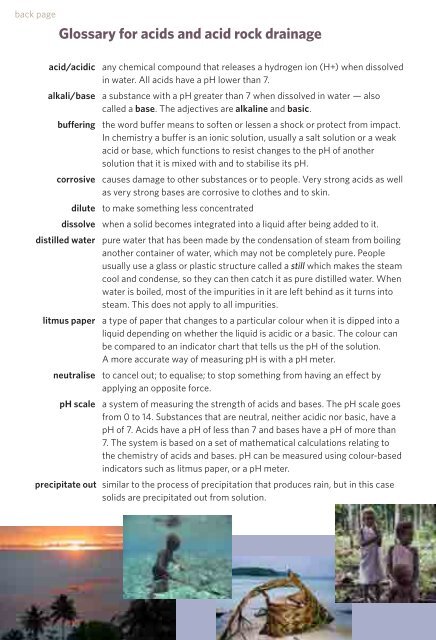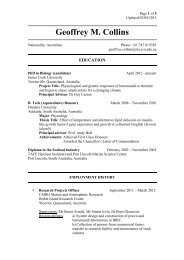Acids and acid rock drainage
Acids and acid rock drainage
Acids and acid rock drainage
Create successful ePaper yourself
Turn your PDF publications into a flip-book with our unique Google optimized e-Paper software.
ack page<br />
Glossary for <strong>acid</strong>s <strong>and</strong> <strong>acid</strong> <strong>rock</strong> <strong>drainage</strong><br />
<strong>acid</strong>/<strong>acid</strong>ic any chemical compound that releases a hydrogen ion (H+) when dissolved<br />
in water. All <strong>acid</strong>s have a pH lower than 7.<br />
alkali/base a substance with a pH greater than 7 when dissolved in water — also<br />
called a base. The adjectives are alkaline <strong>and</strong> basic.<br />
buffering the word buffer means to soften or lessen a shock or protect from impact.<br />
In chemistry a buffer is an ionic solution, usually a salt solution or a weak<br />
<strong>acid</strong> or base, which functions to resist changes to the pH of another<br />
solution that it is mixed with <strong>and</strong> to stabilise its pH.<br />
corrosive causes damage to other substances or to people. Very strong <strong>acid</strong>s as well<br />
as very strong bases are corrosive to clothes <strong>and</strong> to skin.<br />
dilute to make something less concentrated<br />
dissolve when a solid becomes integrated into a liquid after being added to it.<br />
distilled water pure water that has been made by the condensation of steam from boiling<br />
another container of water, which may not be completely pure. People<br />
usually use a glass or plastic structure called a still which makes the steam<br />
cool <strong>and</strong> condense, so they can then catch it as pure distilled water. When<br />
water is boiled, most of the impurities in it are left behind as it turns into<br />
steam. This does not apply to all impurities.<br />
litmus paper a type of paper that changes to a particular colour when it is dipped into a<br />
liquid depending on whether the liquid is <strong>acid</strong>ic or a basic. The colour can<br />
be compared to an indicator chart that tells us the pH of the solution.<br />
A more accurate way of measuring pH is with a pH meter.<br />
neutralise to cancel out; to equalise; to stop something from having an effect by<br />
applying an opposite force.<br />
pH scale a system of measuring the strength of <strong>acid</strong>s <strong>and</strong> bases. The pH scale goes<br />
from 0 to 14. Substances that are neutral, neither <strong>acid</strong>ic nor basic, have a<br />
pH of 7. <strong>Acids</strong> have a pH of less than 7 <strong>and</strong> bases have a pH of more than<br />
7. The system is based on a set of mathematical calculations relating to<br />
the chemistry of <strong>acid</strong>s <strong>and</strong> bases. pH can be measured using colour-based<br />
indicators such as litmus paper, or a pH meter.<br />
precipitate out similar to the process of precipitation that produces rain, but in this case<br />
solids are precipitated out from solution.

















